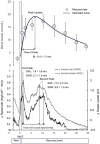Short Report: Estimating Blood Lactate Dynamics from Sweat Lactate and Sweat Rate After High-Intensity Exercise - A Pilot Regression-Based Study
- PMID: 40757007
- PMCID: PMC12318520
- DOI: 10.2147/OAJSM.S534243
Short Report: Estimating Blood Lactate Dynamics from Sweat Lactate and Sweat Rate After High-Intensity Exercise - A Pilot Regression-Based Study
Abstract
Background: Blood lactate (BL) is a critical biomarker for assessing anaerobic metabolism and fatigue. Sweat lactate (SWL) and sweat rate (SWR) have been explored as non-invasive alternatives, but their capacity to estimate BL dynamics after short-term high-intensity exercise remains unclear.
Purpose: This pilot study aimed to evaluate whether BL dynamics can be predicted using a regression model based on the time-series patterns of SWL and SWR measured by wearable sensors.
Methods: Five healthy male athletes (three sprinters and two endurance runners) performed a 30-second Wingate anaerobic test. SWL and SWR were continuously monitored using a wearable electrochemical sensor and a ventilated capsule-type sweat rate meter. Capillary BL was sampled for 30 minutes post-exercise.
Results: BL showed a delayed peak at 6.4 ± 1.2 min, while SWL and SWR exhibited biphasic responses. The second SWL peak (7.5 ± 2.2 min) aligned with the BL peak. Although peak-based correlations were not significant, Pearson correlations using time-series data revealed strong associations (r = 0.501-0.933 for SWL; r = 0.515-0.805 for SWR; all p < 0.001). A multivariate regression model using both variables predicted BL with high accuracy (R² = 0.763, RMSE = 1.612, MAE = 0.995, p < 0.001).
Conclusion: These findings support the feasibility of a regression-based approach using sweat-derived time-series data to non-invasively estimate BL dynamics after high-intensity exercise.
Keywords: blood lactate; high-intensity exercise; non-invasive; sweat lactate; sweat rate; wearable sensor.
© 2025 Hattori and Yashiro.
Conflict of interest statement
The author(s) report no conflicts of interest in this work.
Figures
Similar articles
-
Physical exercise training interventions for children and young adults during and after treatment for childhood cancer.Cochrane Database Syst Rev. 2016 Mar 31;3(3):CD008796. doi: 10.1002/14651858.CD008796.pub3. Cochrane Database Syst Rev. 2016. PMID: 27030386 Free PMC article.
-
Falls prevention interventions for community-dwelling older adults: systematic review and meta-analysis of benefits, harms, and patient values and preferences.Syst Rev. 2024 Nov 26;13(1):289. doi: 10.1186/s13643-024-02681-3. Syst Rev. 2024. PMID: 39593159 Free PMC article.
-
Exercise rehabilitation following intensive care unit discharge for recovery from critical illness.Cochrane Database Syst Rev. 2015 Jun 22;2015(6):CD008632. doi: 10.1002/14651858.CD008632.pub2. Cochrane Database Syst Rev. 2015. PMID: 26098746 Free PMC article.
-
The Black Book of Psychotropic Dosing and Monitoring.Psychopharmacol Bull. 2024 Jul 8;54(3):8-59. Psychopharmacol Bull. 2024. PMID: 38993656 Free PMC article. Review.
-
Systemic pharmacological treatments for chronic plaque psoriasis: a network meta-analysis.Cochrane Database Syst Rev. 2021 Apr 19;4(4):CD011535. doi: 10.1002/14651858.CD011535.pub4. Cochrane Database Syst Rev. 2021. Update in: Cochrane Database Syst Rev. 2022 May 23;5:CD011535. doi: 10.1002/14651858.CD011535.pub5. PMID: 33871055 Free PMC article. Updated.
References
LinkOut - more resources
Full Text Sources



